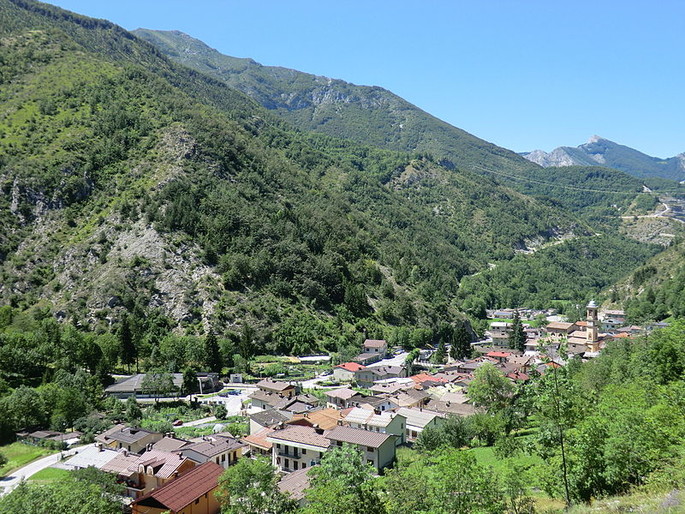The crystalline Argentera massive is close to an embrace of sedimentary rocks that cover the lower Gesso Valley: its ancient seabed became limestone and dolomite. In these rocks much more "soft" and permeable than the peaks of the upper valley, water, seeping through cracks and crevices, over the millennia has dug tunnels and passages. The largest underground system in the valley is represented by Bandit Caves, which open near the Gesso creek , in the Municipality of Roaschia.
Here, they were found remains of Ursus spelaeus, the ancient cave bear. Here the villagers have dug long in search of gold flakes. Here, using the stable climate of the caves, wintering colonies of bats, whose lethargy must never be disturbed,. Here live invertebrate species perfectly adapted to the underground environment.
For their archaeological and natural interest, the caves are now included in the protected area, called the Natural Reserve of the Caves of the Bandit. Since 2012, the Nature Reserve is managed by the Natural Park of the Maritime Alps, they are subject to protection and access to the cavity is limited.
Some 200,000 years ago, during the third glaciation known under the name of Riss, the Valle Gesso was covered by two large ice branches: the first, called Glacier Entracque, was formed by the glaciers: Barra, Rovina and Trinity; the second, that of Valdieri, was formed by the union of Glacier Valletta and Valasco with that of Meris. The two main glaciers were to join upstream of Valdieri forming the largest glacier of Gesso, often about 300 meters thick and almost two kilometer large, which extended to the strangle of Andonno. During the last glaciation, the Wurm, the two glacial arms were separated from each other. The debris carried downstream by the ice are still visible in the moraines of Tetti Bandito and San Lorenzo di Valdieri and in those of Esterate and the Polveriera In more recent times, underground springs such as those near the town of Dragonera Roaschia or the Bandit caves, dug in the limestone galleries and tunnels, forming a dense network of caves including precisely Grotte del Bandito.
In the Quaternary, a period between 66,000 and 30,000 years ago Bandit's Cave was inhabited by populations of extinct bears, known in paleontology as spelei bears and cave bears. They were creatures of considerable size: the larger specimens could reach three meters and a half high upright on its hind legs, to a shoulder height of about one meter and a half. It is estimated that their weight could reach the ton. These numbers place the cave bear among the largest carnivores ever appeared on Earth. The bones of these animals have settled in large numbers on the bottom of the caves of Bandito, known since the nineteenth century for its rich fossil deposits. During the floods of the Gesso, waters invaded the tunnels and underground chambers of the caves, and the debris carried by them, covered the bear skeletons permitting fossilization.
In the late nineteenth century, some branches of the cave were exploited for gold, and in the frenzy of the excavations many fossils were destroyed. For the low yield and the difficulty of sifting the gold rush died down soon.
In the early twentieth century, as evidenced by the writings collected at the Civic Museum of Cuneo, the many bones of bear found in the surroundings of the cave were used by Roaschia's children as entertainment, to build "trains" of bone and other toys. Also during the twentieth century many excavations brought to light, as well as remains of bear, also remains of several other animals, some of which ascribable to attendances of the cave by prehistoric man. In 1967 was found a knife in bronze attributed to the early Iron Age.
The cave is now of biospeleological interest, for the presence of rare amphibians and several arthropods. These caves are typicus locus of Eukoenenia spelaea and are inhabited by Diplopode Plectogona winemakers, from Chilopode Lithobius scotophilus from CarabideTrechino Duvalius carantii and it is easy to find the beetles troglophile Sphodropsis ghilianii, on the loose gravel on the bottom, Dolichopoda ligustica on the walls, along with Limonia nubeculosa and Moths in the parietal association. On the vault of the tunnels in the vicinity of the many inputs can be observed spiders troglophile as Meta menardi (subtroglofilo) and Nesticus hermit (eutroglofilo). In the same areas, but on the ground or on the walls, is often present the Geotritone (Speleomantes strinatii). Furthermore, they were found 13 different species of bats including greater horseshoe bat, Rhinolophus hipposideros, Barbastella barbastellus, Myotis myotis, Geoffroy's bat, Natterer's bat, Nyctalus leisleri, brown long-eared bat. .
It is a visit described without danger but only suitable for those who can crawl in narrow passages that characterize the picturesque route.
LOCATION: latitude: longitude 44.17.23: 05.01.32 surface: 9.53 cartography has reference: IGM 1: 25000: 90 / I / NE Valdieri.























